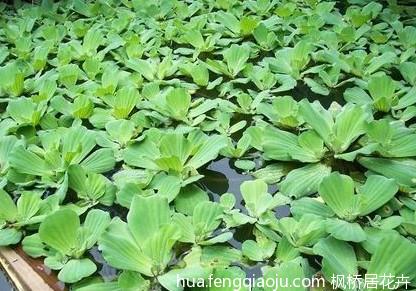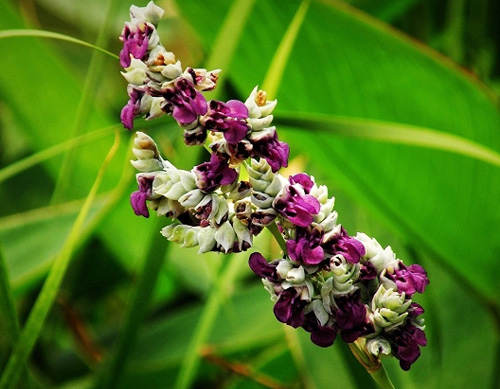Introduction and ecological habits of Dazhu (Chinese cabbage and water lotus)
Dazu (water cabbage, water lotus)
Scientific name: pistia stratiotes
Aliases: water lotus, duckweed, water lotus, fat pig grass, water hibiscus, water water lotus
Family and genus: Artemisia of the family Araceae
Morphological features: perennial floating herbs. Stoloniferous, basal leaves, rosette-shaped clusters, sessile, floating on water, leaf veins obvious, so that the leaves into a folded fan. Inflorescences of fleshy spikes axillary, spawn small, light green.
Ecological habits: like high temperature, high humidity, not cold-resistant. East China and South China grow well and propagate rapidly, so they belong to alien invasive species.
Flowering language: June to July.
Garden uses: green leaves, strange leaf shape, suitable for rivers, ponds, canals and other fertile still water or slow-flowing water surface, or tank culture and ornamental.

Name: Daishi
Scientific name: PistiastratiotesL.
Aliases: Dazhou, Dazhong, water lotus, fat pig grass, water hibiscus
Family and genus: Artemisia of the family Araceae
Category: perennial floating herbs
Morphological characteristics
Perennial floating herbs. The main stem is short and the leaves are rosette-shaped, the stolons are separated from the leaf axils around, the new plants are sent out at the top of the stem, and there are white bundles of fibrous roots. Leaves clustered, leaf blade Obovate-cuneate, long 2~8cm, tip obtusely round and microwave-shaped, with white fine hairs on both sides. Inflorescence leaves axillary, with short involucral pedicels, flame bracts ca. 1.2cm, white, abaxially hairy. The fruit is a berry. Florescence from June to July
Distribution of producing area
It is distributed or cultivated in all provinces and regions south of the Yangtze River in China.
Growth habit
Sex likes high temperature and humidity, and is not resistant to severe cold.
Reproduction
It's very fertile.
Ornamental application
In the garden waterscape, it is often used to decorate the water surface. A small pond in the courtyard is planted with a few carps, and then several carps are released to make the environment elegant, natural and interesting. The well-developed root system can absorb harmful substances and excess nutrients directly from the sewage and purify the water body.
[alias] sow lotus, water lotus
[source] PistiastratiotesL., a plant of the genus Artemisia in the family Araceae, is used as medicine in terms of leaves. Harvest in summer and autumn and dry in the sun.
[nature and taste is classics] it is pungent and cool.
[functional indications] expelling wind and sweating, diuresis and detoxification. For colds, edema, adverse urination, rheumatism, skin itching, urticaria, measles impermeable; external use to treat sweat spots, eczema.
[usage dosage] 3: 5 yuan; for external use, apply fresh juice or fry water to wash the affected area.
[note] pregnant women should not take it.
[excerpt] National Compendium of Chinese Herbal Medicine
Key points of Garden Conservation of Aquatic plants
Aquatic plants are a kind of plants that live in water or moist soil for a long time and can complete the reproductive cycle. A variety of leaves, colors, flower shapes and seeds of aquatic plants, they can show a variety of interest. According to the life form, it can be divided into:
Wet plants-Reed, reeds, calamus, variegated awn, pennisetum and so on.
Standing water plants-Acorus tatarinowii, starlight grass, Chiqingcai, lotus and so on.
Floating-leaf plants-Euryale, water lily, water poppy, king lotus, water poppy, cabbage and so on.
Floating plants-sophora leaf duckweed, water grass, sea cauliflower, big fish and so on.
Submerged plants-black algae, bitter grass, Rabdosia angustifolia, bamboo leaf and so on.
Key points for garden conservation of aquatic plants:
1. Adaptability of water depth
In addition to floating plants, the ecological factor that has the greatest impact on aquatic plants is the depth of water, which directly affects the survival of aquatic plants.
Wet plants, such as wild buckwheat, zebra grass, Reed and so on, can only be planted above normal water level.
There are many kinds of water-holding plants, and the adaptability to water depth is related to the plant height. The tall plant has a strong ability to adapt to the water depth, on the contrary, the ability is poor. But generally speaking, the depth of water cannot be greater than 60cm.
Floating-leaf plants are generally more adaptable to water depth than water-bearing plants. For example, the water lily is generally 0.8m, and the water depth of Euryale can reach 1.5m. Linnaeus is also a kind of very interesting plant. As a floating-leaf plant, its adaptability to water depth can reach 3m. When the plant grows to a certain extent, it can cut off its roots and become a floating plant, which is not limited by water depth.
The water depth adaptability of submerged plants is affected by the visibility of light and water. The better the visibility of the water, the stronger the light, the deeper the distribution of submerged plants. In general, submerged plants are planted at twice the depth of visibility.
2. Planting density
The design density of aquatic plants is based on the fact that all the aquatic plants cover the ground (water surface) after restoration, and the construction density is based on the tillering, branching characteristics, planting season and fertility of the planting soil. combined with the completion acceptance time and other factors to determine a planting density, construction density has practical value for saving construction cost.
3. Planting season
Most of the aquatic plants are herbaceous plants. In the growing period, especially in the high temperature season, the germination and growth rate of new shoots is very fast, the root activity is exuberant, and it is easy to recover. Generally, aquatic plants can germinate new roots after 1-2 days after root injury, and plant morphology can be effectively restored after 10-30 days after planting in the growing period.
Species with strong cold tolerance can be planted in the dormant period, such as onion, Zili flower, Reed, water lily, Reed bamboo, calamus, Qianqu vegetable and so on. The injured roots of these plants can withstand the test of long-term low temperature and have the physiological characteristics of resistance to low temperature.
Species with poor cold tolerance must be planted during the growing period, and this kind of plant is very easy to cause frost damage when it is planted during dormancy. Such as barracuda, flower and leaf onions, papyrus, parasol, Egyptian sedge, aquatic canna and so on. If this kind of plant is planted in the growing period, the root soil temperature is high, the root activity is exuberant, and the plant recovers quickly.
Low-temperature areas relative to plants must be planted during the growing period. For example, papyrus originating in tropical Africa and ginger flowers originating in South and Southwest China can only be planted in the growing period in Hangzhou and the north, otherwise they are vulnerable to death from freezing injury.
4. Normal water level
Many aquatic plants die in a large area after planting, and the important reason why they can not achieve the desired effect is the problem of water level control. It can be seen that the constant water mark is the lifeline of aquatic plants. In the actual construction operation, enough attention should be paid to the constant water level line. It is suggested that the normal water level should be determined by the level before setting out in the planting construction. In the plant configuration, the water depth adaptability of all kinds of plants is considered as a hard index.
5. Wave influence
The small water system generally has a small area and slow flow, which has little effect on the planting and growth of aquatic plants. Rivers and lakes and other water bodies bring great difficulties to the planting and survival of aquatic plants due to the rapid erosion of wind waves, boat waves or currents. According to the characteristics of waves, the corresponding technical measures of wave dissipation and bank revetment should be taken when planting. Pine piles and bamboo piles can be used for the shorelines of lakes and rivers where the lake surface is small and the waves are not big. They can not only dissipate the waves but also stabilize the bank, which is a better choice. Can also be used with the landscape combined with the shoreline stacked stone treatment, stacked stones are scattered, not only to meet the needs of the landscape, but also to eliminate waves and stabilize the bank. After the restoration of aquatic plants, aquatic plants can play a certain role in wave dissipation, and its root system can also play a certain role in slope protection and bank stabilization.
- Prev

The pruning method of Majiu wood (diagram)
Pierisjaponica, also known as soaking wood, is an evergreen shrub of the genus Ericaceae. In addition to the native species to the south of northeastern Japan, there are also hybrids between Yunnan native species and Japanese species. There are many kinds of gardening. Keep the height of the courtyard and hedge below 2m
- Next

Cultivation and management methods of Zili flower (water bamboo taro)
Then the scientific name of thaliadealbata: water bamboo taro, water lotus banana, Talia. Family and genus: Taro family Talia morphological characteristics: perennial Tingshui herbs, plant height 2m. The whole plant is covered with white powder, leaves ovate-lanceolate, light grayish blue, margin purple, 50 cm long
Related
- Fuxing push coffee new agricultural production and marketing class: lack of small-scale processing plants
- Jujube rice field leisure farm deep ploughing Yilan for five years to create a space for organic food and play
- Nongyu Farm-A trial of organic papaya for brave women with advanced technology
- Four points for attention in the prevention and control of diseases and insect pests of edible fungi
- How to add nutrient solution to Edible Fungi
- Is there any good way to control edible fungus mites?
- Open Inoculation Technology of Edible Fungi
- Is there any clever way to use fertilizer for edible fungus in winter?
- What agents are used to kill the pathogens of edible fungi in the mushroom shed?
- Rapid drying of Edible Fungi

